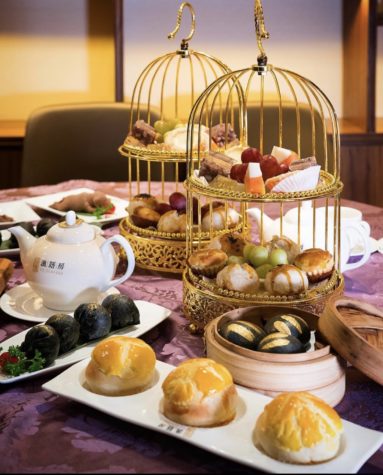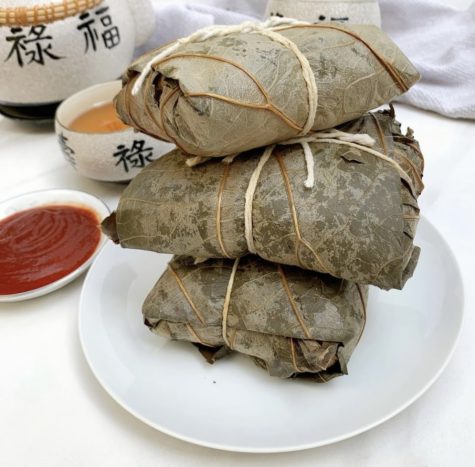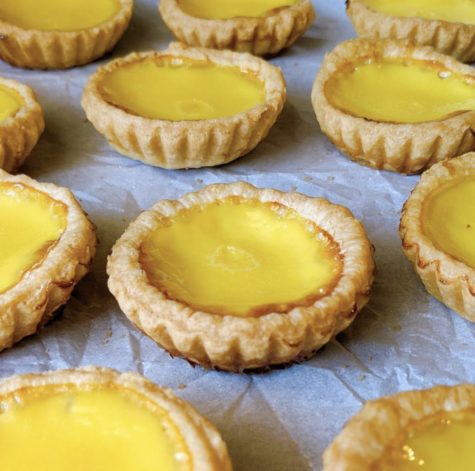Touch the Heart with Dim Sum
Dim Sum offers a respite from life’s stresses in the form of bite-sized appetizers — all hand-crafted and delivered on rolling carts.
Used by permission of Katie (@thebellychronicles)
Dim Sum provides an inexpensive communal meal, best enjoyed through little bites.
Dim Sum is a Cantonese word that translates directly to “touch the heart.” Typically consumed at brunch, it refers to a large selection of hors d’oeuvres accompanied by piping-hot tea.
The meal originates from the Guangdong region of China where nineteenth-century Silk Road merchants made regular stops in order to fill their stomachs at the teahouses which scattered the port city. Yī zhōng liặng jiàn quickly became the signature menu item, meaning “one cup, two pieces,” because customers were served two plates of sweet and savory Dim Sum in order to complement their tea.
The locations were quaint and shabby, serving as leisure spots for locals to gossip over freshly brewed tea. However, as the capital city of Guangzhou gained international attention for its temperate climate, glistening coastline, and fresh tropical ingredients, so too did its Dim Sum. Consequently, the menu expanded alongside the scale of its teahouses. Thanks to travelers, the trend slowly made its way southward to Hong Kong and across the Pacific Ocean to the United States.
Dim Sum remains a staple in Chinese communities. Due to its reputation as a brunch meal, some restaurants open from as early as five in the morning to three in the afternoon, although most locations opt for the conventional nine to five. The place that my family frequents, East Buffet in Flushing, operates later than usual, opening its doors at eleven.
Despite this, my mother is always in a hurry to get us out the door. I suppose that spending forty minutes on the waiting list years prior strengthened her conviction that being ‘on time’ means being early. On those mornings, we frantically grab our belongings, rush into the car, and anticipate the delicious meal that awaits us.

East Buffet is lavishly decorated with a heavy crystal chandelier and spiral staircase in its main lobby, because most Dim Sum parlors double as a space for wedding receptions and other festivities. Circular tables draped in creamy linen cloth and plush chairs are placed sporadically throughout the restaurant, with more mini chandeliers and circular curtain drapes lining the ceiling and the walls.
Upon entering, a uniformed staff member in a swirl-patterned vest escorts people to their table. While most people aim for a seat near the kitchen in the hopes of receiving hotter dishes more quickly, I prefer sitting near the wall-length windows. While the service is slower at that section, it is perfect for people-watching.
East Buffet is located at a four-way intersection, so the vibrancy of life passing through is endless. One notes the delivery drivers unloading fresh fruit into the supermarket across the corner, moms on an outing with their children, and teenagers loitering at storefronts — all provide entertainment like no other. There is also a unique delight that comes from knowing that while others are rushing to work, I get to enjoy a slow meal with my family on a Saturday morning.
Inside the restaurant, it is equally hectic, if not more so. One of the main appeals of eating Dim Sum is the noisy atmosphere. The sound of grandparents, friends, and siblings from over forty tables simultaneously talking over one another creates a comfortable layer of chatter that fills the venue. It is hard to discern anything else, aside from the three conversations happening at one’s own table, and the hustling of carts and silverware. It is also common to see three generations at one table as well. These large, informal gatherings provide a great way to catch up with loved ones through a shared meal.

It is likely that one will notice familiar faces at their Dim Sum location due to its popularity within the Asian community. Once, when my parents invited my maternal grandmother to brunch, I spotted my sixth-grade science teacher at the table behind us. Needless to say, I was caught off guard.
‘Yum Cha’ or ‘drink tea’ is almost as important to Dim Sum culture as the food itself. Typically, servers will bring the table a scalding pot of either Bo Lay (black tea), Oolong, Green, or Chrysanthemum tea at the start of the meal. For novice tea drinkers like myself, I recommend the last one as it is refreshingly simple but still gives one the feeling of being a connoisseur. The tea can become intoxicating, especially when waves of steam roll onto your face, creating a teacup-contained sauna.
When we were kids, my sisters and I would extend our pinkies while sipping our tea, imitating the royalty we’d seen in countless Barbie princess movies. Combined with the lavish decor, it was not difficult to become lost in this role playing.

Like other aspects of Chinese culture, having Dim Sum incorporates the Confucian value of filial piety. Although the rules have been relaxed in recent years, it is customary to pour a cup for the eldest members of one’s party first. This may be met with two-finger taps on the table as a non-verbal gesture of thanks.
Dim Sum restaurants are also characterized by how they cater to their customers. Most traditional locations like East Buffet are cart-style, which means that apron-adorned aunties push metal trollies alongside tables full of hungry diners. The puffs of steam trailing the carts give the experience an ethereal quality, transforming the droplets of mushroom, lotus leaf, and hot oil aroma into puffs of cloud.
Unlike most western establishments, this Cantonese-style meal does not serve appetizers first, followed by the main course and dessert. Rather, people are free to chase the carts if anything catches their eye (or stomach).
While each cart looks the same, the cart’s contents are very different. Although the practice diminished in recent years, it was once very common to hear the aunties call out their cart’s cargo like street vendors. One may have BBQ pork buns while another has xiao long bao (soup dumplings). This creates the perfect breeding ground for spontaneity. Steamed Malay sponge cake rolls, one of my favorite dishes, was discovered this way.

Digital food creator ‘eatnmingle’ wrote, “This is my kind of ‘Brunch.’ I grew up eating Dim Sum, hearing the loud clanking of porcelain teacups and plates against plastic chopsticks, rickety steel carts, and the loud yelling of delicious offerings stored in the hot bamboo steamers — it’s all part of the experience. I loved seeing small plates arrive at the table because small portions meant more variety of dishes….It’s not the same experience ordering dim sum as take-out nowadays, but…the taste and flavors really can’t be forgotten!”
In Dim Sum, Har Gow (shrimp dumplings), Siu Mai (open-top steamed pork dumplings), Char Siu Bao (barbecue-pork-filled bun), and egg tarts can be found at nearly every restaurant. These carefully crafted delicacies are referred to as ‘The Four Heavenly Kings.’ A Dim Sum chef’s skill level can be assessed by how flawlessly they make these four dishes. If a chef can make ten clean plates of Har Gow, they pass the test. Despite looking simple, the dish’s translucent crystal skin requires years of handiwork.
While people are encouraged to try new things, my family has a rough list of items that we order each time: zhaliang, fèngzhuặ, tripe, beef short ribs in black pepper sauce, and pork spareribs in black bean sauce.
Zhaliang are fried dough “breadsticks” enveloped in silky smooth sheets of rice noodles, and drizzled in sweet soy sauce. The winning combination is both sweet and salty, chewy, slippery, and crispy. The fèngzhuặ (or phoenix claws) are gelatinous deep-fried, boiled, and steamed chicken feet — a great dish to order if one wants to scare their non-Asian friends.
On the other hand, some dishes are better enjoyed not knowing what it is. I had always thought that tripe was some strange sea creature due to its honeycomb-dotted texture, like a cross between a jellyfish and octopus. If I had initially known that tripe comes from the stomach lining of various animals, I would not have tried it; so my motto is “eat first, ask later” or maybe don’t ask at all.
The funniest part of the experience ensues after the meal. Each time food is ordered, the aunties will stamp the table’s meal card which will later be used as a bill. In Chinese families, they keep close tabs on those who excuse themselves to the restroom, because they could be sneaking away from their part in paying the check. If no one is successful, there is a lighthearted competition where relatives fight to pay for the meal.
Despite all of my reminiscing, it has been over two years since I’ve had the full Dim Sum experience. Due to the COVID-19 pandemic, many locations have reduced their selections or closed their doors completely. While my parents order take-out of the sweet cream bun, lotus leaf sticky-rice wrap, and egg tarts, an authentic Dim Sum experience is one with rolling carts of bamboo steamers, harried staff, and freshly brewed tea, all mixing within a sea of conversation.
Angel Opedal, a graduate student “eating her way through New York City” puts it perfectly. “I think cart chasing really puts you into the whole Dim Sum experience. There’s just something special about the fresh tea, hardworking ladies yelling at me to try a new dish, and having everything come out fresh from the kitchen. If I’m craving dim sum and feeling too lazy to sit down somewhere, I will never say no to the takeout, though! I know some people might be nervous if they don’t speak the language, and I don’t at all either…Although it would make things easier sometimes, I wouldn’t say that that becomes an issue when I want to enjoy all my favorite dishes. You just have to be there in the moment, ready to eat, and be ready to point at what you want. Be brave and yell after those carts!”
At the center of Dim Sum is family — sitting with loved ones on a Saturday morning, celebrating special occasions, and sharing delicious food. It is a meal on a mission, bringing hearts closer with every bite.
Digital food creator ‘eatnmingle’ wrote, “This is my kind of ‘Brunch.’ I grew up eating Dim Sum, hearing the loud clanking of porcelain teacups and plates against plastic chopsticks, rickety steel carts, and the loud yelling of delicious offerings stored in the hot bamboo steamers — it’s all part of the experience. I loved seeing small plates arrive at the table because small portions meant more variety of dishes….It’s not the same experience ordering dim sum as take-out nowadays, but…the taste and flavors really can’t be forgotten!”
Nicole Zhou is the Editor-in-Chief for ‘The Observatory' yearbook and a Staff Reporter for 'The Science Survey' newspaper. This is her third year revising...

